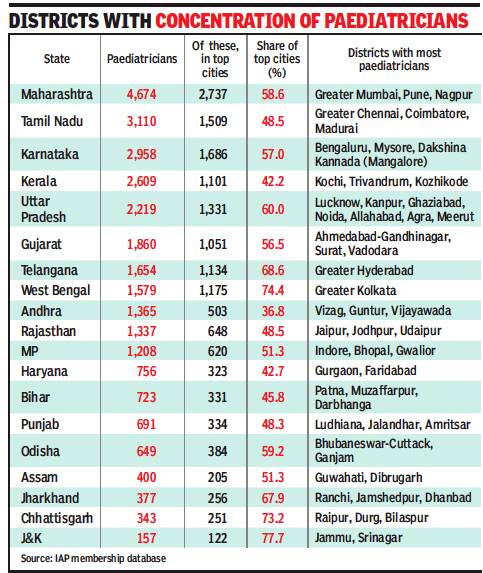Paediatricians: India
This is a collection of articles archived for the excellence of their content. |
State-wise availability
As in 2019
Rema Nagarajan, September 14, 2020: The Times of India

From: Rema Nagarajan, September 14, 2020: The Times of India
Child specialists aren’t where most of India’s kids are
4 States Account For 50% Of Births, Just 17% Of Docs
UP, Bihar, MP and Rajasthan between them account for nearly half of all children born in India each year but have barely one-sixth of the paediatricians in the country. The imbalance between where the need for child specialists is and where they are available is just as pronounced within states with most of them concentrated in the bigger cities while the villages are where most children are.
In UP and Bihar, which have the largest child populations, for instance, a large chunk of paediatricians, about 60% and 46% respectively, are concentrated in the top few cities. The skew in distribution within larger states is worst in West Bengal where over 74% of paediatricians in the state are in the Greater Kolkata region.
Several districts without a single paediatrician: IAP data
The skew in distribution of paediatricians within larger states is worst in West Bengal where over 74% of paediatricians in the state are in the Greater Kolkata region, followed by Telangana, where almost 69% are in the Greater Hyderabad area.
This skew was revealed when the Indian Academy of Pediatrics (IAP), the largest association of paediatricians, did a district-wise mapping of its 31,176 members. The IAP claims its membership covers over 90% of paediatricians in India. While skew in availability of specialists is old hat, the extent of that skew is usually hard to come by as Digital India has no database on district-wise or even state-wise availability of doctors, let alone specialists. There isn’t even a system of unique ID number for the estimated 11 lakh-plus doctors, 20 lakh nurses and other categories of health personnel.
The IAP database shows there are several districts without a single paediatrician and 125 with less than five. There are very few paediatricians in the North Eastern states and over 80% of those that are there are to be found in the state capitals.
Maharashtra has the highest number of IAP members, 4,674, but almost 60% are in Greater Mumbai, Pune and Nagpur. This is followed by Tamil Nadu, Karnataka and Kerala in that order. However, in Tamil Nadu and Kerala, there appears to be a somewhat better distribution across districts, probably because of higher levels of urbanisation. “We are aware of the skew in distribution of paediatricians. That is why digital IAP, or dIAP a new division of IAP, is working to create webinars and lectures for those working far from the metros where there are fewer opportunities of getting regularly updated in the field. We are also working to put in place a mechanism for teleconsultation so that even non-paediatricians having to treat children can get help from experts,” said IAP president Dr Bakul Parekh.
Dr Yogesh Jain, a paediatrician and public health expert working in Chhattisgarh, pointed out that not only is the proportion of sick kids seen by paediatricians small, the need for a specialist or even a doctor is not that high. “We need more well-trained and mentored mid-level health providers who should be supportively supervised if kids in rural areas are to be helped,” he said, adding that tele-teaching has a greater role than tele-consults.